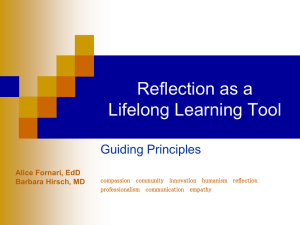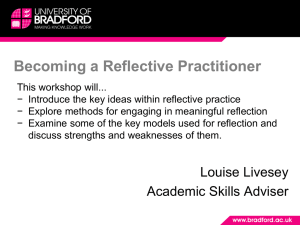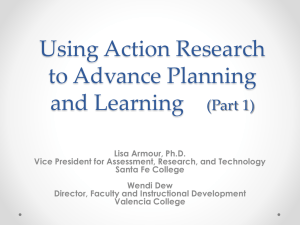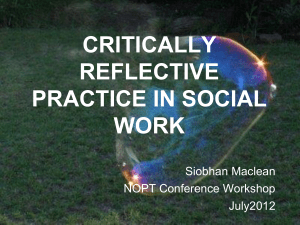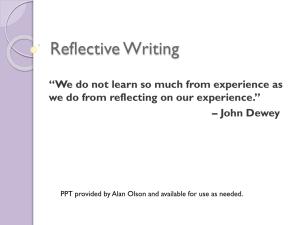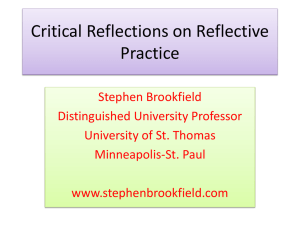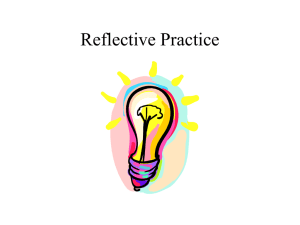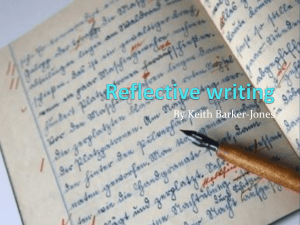REFLECTION
advertisement
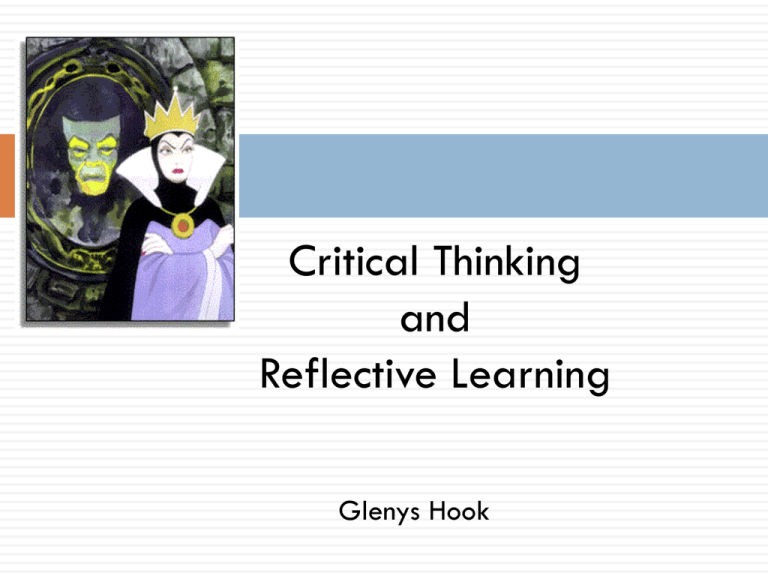
Critical Thinking and Reflective Learning Glenys Hook Reflection “…reflection in the context of learning is a generic term for those intellectual and affective activities in which individuals engage to explore their experiences in order to lead to new understandings and appreciations” Boud 1985 What is Reflective Practice? Taking the opportunity to think about the work you are doing, as you do it, or after you have done it. ‘… looking back on an experience and making sense of it to identify what to do in the future.’ (Drew and Bingham, 2001 p221) ‘…do something, think about it what you did, come to conclusions about what you did and plan to try again.’ (Kolb 1984) ‘ The art of writing things down helps you to clarify your thoughts and emotions, to work out strategies, and to focus on your development and progress…’ (Cottrell, 2001 p67) This can be done in a ‘weblog’, or blog – you will need to: reflect on personal, academic and professional development For assessment, keep four entries Start of module – expectations, skills Report assessment experiences Presentation assessment experiences End of module – the full experience! Why should you be reflective practitioners? To enable professional development The ‘knowledge’ economy Continuous professional development To maintain quality Reflecting on what went wrong and why = improvement Reflecting on what went well and why = good practice Reflection Reflection then includes hard systematic thinking and a soft initiative insight, leading to a plan of action based on critical evaluation of all the available evidence. Don’t just think about what went wrong/well and why – also plan to improve skills if necessary, or to use those skills in future events Assessment A 'reflective practitioner' is someone who does something and is automatically reflective Reviews what happened and asks 'why?', 'how?’, ‘where?’,’ what?‘ What skills can you take forward/ need to improve/develop? How will I do this? The best practitioners are constantly learning, evaluating and refining their practice, even after years of experience. The next stage is to apply what you have learned from one situation to the next What can reflective practice do for me? Enhance your self awareness Develop creative answers to difficulties Enhance your problem solving skills Enhance your ability to evaluate Enhance your ability to action plan for success Make you an effective manager Kolb’s Learning Cycle (1984) Taking stock What do I know? Individual Planning How can I take my learning further? Developmental Reflection What do I need to know? Contextual Feedback/ evaluation How much and how well do I understand? Relational Reflection on Practice (Ghayle 1998) Navel Gazing Learning from the day’s chaos Talking about what you do with others Learning from experience Reasoning Remembering when Being honest with yourself Becoming more aware Constructive criticism Improving what you have Doing it after a lesson done Understand your feelings Re-assembling what you do Questioning yourself Letting go of personal prejudice Something done by reflective practitioners Gaining confidence in your work Hard work The latest bandwagon What you do academically Dwelling on mistakes Justifying what you do Personal growth Helping you to see what you would or would not do again and why Critical Thinking “An investigation whose purpose is to explore a situation, phenomenon, question, or problem to arrive at a hypothesis or conclusion about it that integrates all available information and that can be therefore be convincingly justified” Kurfiss 1988 CT as a process (Cottrell 2005) Identify other people’s positions/ arguments/ conclusions Evaluate the evidence for alternative points of view Weigh up opposing arguments/ evidence fairly Read between the lines Identify false/ inaccurate assumptions Recognise techniques to make certain positions appealing Reflect on issues in a structured way, bringing logic to bear Draw conclusions- valid/ justified Present a point of view Benefits Improved attention and observation Integration of theory and practice New and expanded knowledge Safe and effective practitioners Protection of the public Context of practice Changing needs Ownership and responsibility Ability to identify key points in a text/ message Stimulates enquiry, increases self awareness. Develops analytical skills Encourages learning Assists practice teachers in analysing the quality of the student’s competencies Implications for future practice. Focused reading Ability to respond to appropriate points in a message Barriers to Critical Thinking (Cottrell 2005) Misunderstanding of what is meant by criticism Over estimating personal reasoning abilities Lack of methods, strategies, practice Reluctance to critique experts Affective reasons Mistaking information for understanding Insufficient focus and attention to detail Models Critical Analysis (Edwards 1998) Re-evaluation (Boud 1985) Reflection in and On Action (Schőn 1987) Gibbs 1998 Driscoll 1994 Johns 1995 Reflecting in and on Action (Schőn 1987) In Action: practising, influences decisions and care at that moment, Promotes skilled and flexible responses of the expert practitioner On Action: After the event, views different interventions, adds knowledge Promotes development of professional skills and knowledge Gibbs reflective cycle ( 1998) Description – what happened? Feelings- what were you thinking and feeling? Evaluation- what was good and bad about the experience? Analysis: what sense can you make of the situation? Conclusion- what else could you have done? Action plan- if it arose again what would you do? Driscoll’s model of reflection ( 1994) WHAT? Returning to the situation SO WHAT? Understanding the context NOW WHAT? Modifying future outcomes Barriers Matter of choice Adoption of a reflective approach Organisational structure which inhibits rather than encourages reflection Resistance to change Lack of time Past negative experiences/ presumptions Lack of self awareness/ intervening skills Other’s expectations Negative factors which impede learning References and Bibliography Boud D, Keogh R& Walker I edit (1985) Reflection: Turning Experience into Learning. London Kogan Page Cottrell S. (2005) Critical Thinking Skills. Basingstoke. Palgrave Macmillan Edwards SL (1998) Critical thinking and analysis: a model for writing assignments. BJN 7(3) 1590166 Gibbs G (1988) Learning by doing: a guide to teaching and learning methods. London FEU Driscoll JJ (1994) Reflective Practice for Practise- a framework of structured reflection for clinical areas. Senior Nurse 14 (1) 47-50 Ghaye A & Ghaye K (1998) Teaching and Learning through Critical Reflective Practice. London Fulton Publishers Johns C (1995) The value of reflective practice for Nursing. JCN 4, 23030 References and Bibliography Johns C (2000) Becoming a reflective Practitioner. Oxford Blackwell Science Kolb DA (1984) Experiential Learning: experience as the source of learning and development. New Jersey Prentice Hall. Moon J (2004) A Handbook of Reflective and Experiential Learning: theory and practice. London Routledge Falmer Osterman K& Kottkamp R () Reflective Practice for Educators. 2nd edit. California Corwin Press Palmer AM, Burns S& Bulman C (1994) Rrflective Practice in Nursing: the growth of the professional practitioner. Oxford Blackwell Science Scaife J (2010) Supervising the reflective Practitioner: an essential guide to theory and practice. London Routledge Schőn DA (1987) Educating the Reflective Practitioner. San Francisco Jossey Bass. Thompson S& Thompson N (2008) The Critically Reflective Practitioner. Basingstoke Palgrave Macmillan


